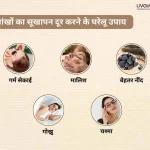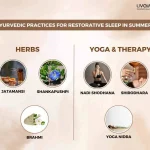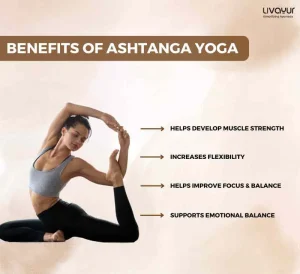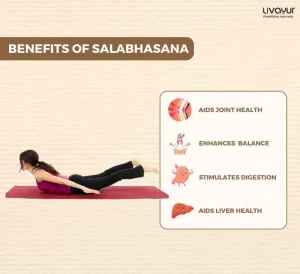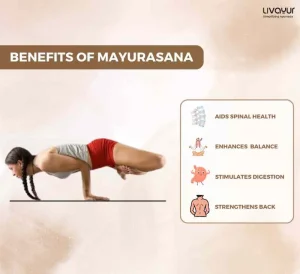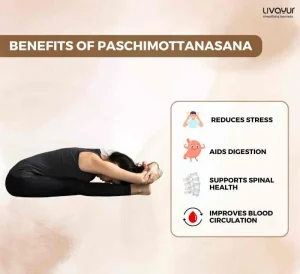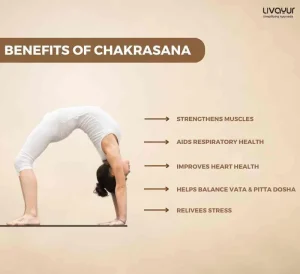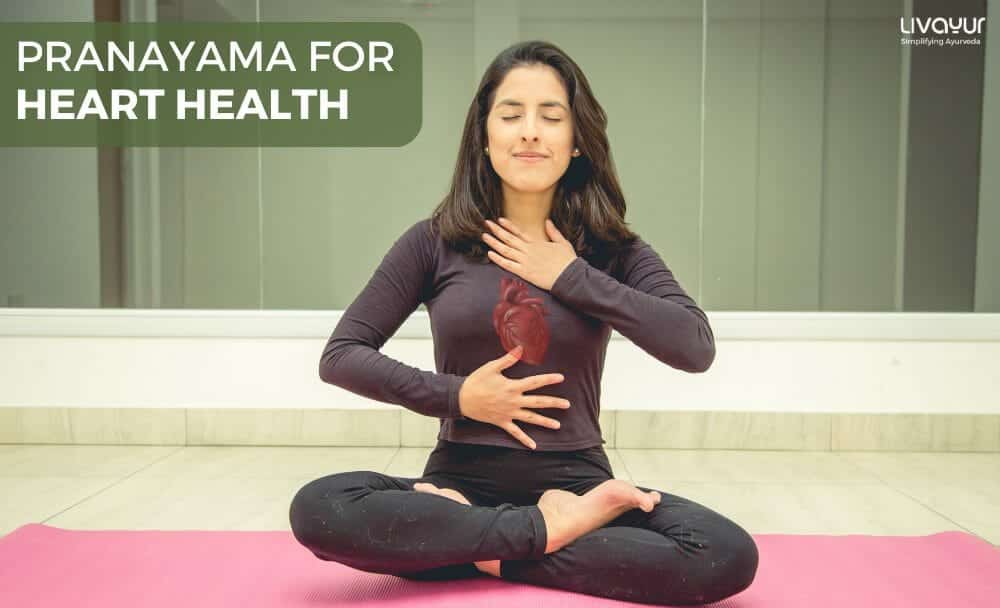
“व्यायामात् लभते स्वास्थ्यं दीर्घायुष्यं बलं सुखं।
आरोग्यं परमं भाग्यं स्वास्थ्यं सर्वार्थसाधनम्॥”
Vyaayaamaat labhte dirghayushya bal sukh
Aarogya param bhaagye svaasthya sarvaarthsaadhanma
The greatest asset in life is one’s health. It is the one thing in life that is necessary to accomplish everything else. Exercise is the key to achieving optimal health, happiness, strength, and longevity.
Do you know about Pranayama? Embedded in yogic science, Pranayamas are breathing techniques that serve specific purposes. The word Pranayama has two components: Prana (which means vital energy) and Ayama (which means expansion or extension). Thus, the word Pranayama means expansion or extension of the dimension of Prana.
From alleviating depression to helping manage high blood pressure levels, there are innumerable benefits of Pranayama. One of these benefits includes improvement in heart health and prevention of cardiovascular diseases.
Let’s read more about the benefits of Pranayama for heart health here. However, before we dig deep into that, let’s understand the connection between these two.
Heart Health and Pranayama
Heart health and cardiovascular functions are successfully controlled by neural as well as other factors such as temperature and hormones, among others. Of these, neural factors majorly concern the autonomic nervous system (ANS), which plays a primary role in the maintenance and regulation of cardiac functions, such as heart rate (HR), systolic blood pressure (SBP), and diastolic blood pressure (DBP). Imbalances in these can lead to cardiovascular problems, such as infarction, ischemia, and hypertension.
Cardiovascular disease is, by far, the leading cause of death in both men and women. Lifestyle modifications are key factors when it comes to the prevention, treatment, and rehabilitation of cardiovascular diseases. Yoga is one of the most optimum lifestyle modifications as well as an ancient Vedic science, which is being increasingly applied in the field of therapeutics. It includes practice of specific postures (asanas) and regulated breathing (Pranayama). Breath is the most important, dynamic bridge between mind and body, making Pranayama one of the most crucial yogic practices.
When it comes to Pranayama practices, there are four vital aspects of breathing: (1) Puraka (inhalation), (2) Recaka (exhalation), (3) Antah Kumbhaka (or internal breath retention), and (4) Bahih Kumbhaka (or external breath retention). A highly advanced stage of Pranayama that occurs during intense meditation is known as Kevala Kumbhaka (or spontaneous breath retention).
Stress (either mental or physical) is known to cause cardiovascular morbidity. In one study, the practice of various Pranayama techniques over the course of two months was shown to reduce levels of stress and low frequency of heart rate variability (HRV) spectrum (indicating reduction in the sympathetic drive to the heart), and an increase in a high frequency of HRV spectrum (indicating an increase in the parasympathetic output to the heart, along with an overall reduction in low frequency/high-frequency ratio, thus indicating an optimum sympathovagal balance. Therefore, Pranayama produces a relaxed state, wherein parasympathetic activity overrides sympathetic activity.
Regular practice of Pranayama was shown to reduce sympathetic tone within a period of just 7 days. Another study successfully reported that changes in autonomic responses to breath-holding is most probably due to an increase in vagal tone and a decrease in sympathetic discharges. In those individuals with arrhythmia and hypertension, practice of Pranayama has proven to produce a significant reduction in indices of ventricular repolarization dispersion and optimum control of blood pressure, respectively. Hence, when it comes to Pranayama for heart health, studies indicate a positive association.
Slow and Fast Pranayama for Heart
In a prior study on slow Pranayama techniques (such as Nadi Suddhi, Mukhabhastrika, Savitri, and Pranava Pranayamas) which were practised for 20 minutes each day for a total duration of three months, it was demonstrated that Pranayama modulated ventricular performance by increasing parasympathetic activity, while simultaneously decreasing sympathetic activity.
Diverse types of Pranayama types were shown to produce diverse physiological responses. For instance, with the practice of Savitri Pranayama (which is a form of slow, rhythmic, deep breathing) there was a subsequent reduction in heart rate, rate pressure product, and double product. On the other hand, with the practice of Bhastrika Pranayama (which is a form of bellows-type rapid, deep breathing) there was an increase in all the aforementioned parameters.
In several other studies, both fast types of Pranayama (such as Bhastrika, Kapalabhati, and Kukkuriya Pranayama) and slow types of Pranayama (such as Pranava, Savitri, and Nadi Sodhana) were shown to be highly efficacious in reducing overall stress levels. Further, the beneficial effects on cardiovascular parameters were observed only after the practice of slow Pranayama/breathing types and not after fast Pranayama/breathing types.
Thus, it can be concluded that Pranayama for heart health is a successful phenomenon.
Health Benefits of Pranayama
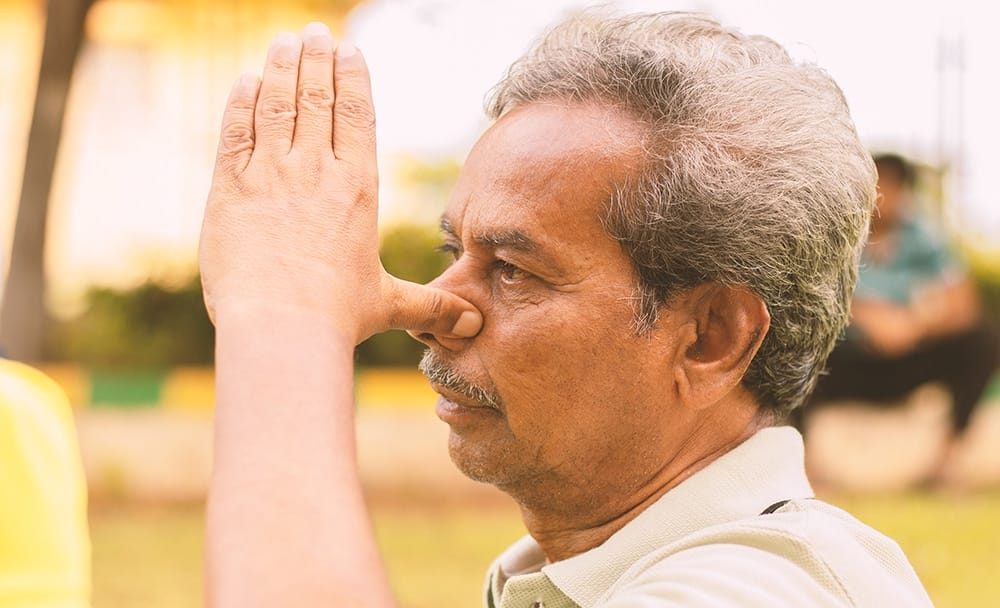
As per studies, the scientific benefits of pranayama aim to strengthen the connection between your body and mind by promoting relaxation and mindfulness. Emotional stress can have different effects on the body, like releasing hormones like cortisol and adrenaline, which narrow your arteries and increase blood pressure. Pranayama is a beneficial practise to manage such factors. Here are some health benefits of pranayama:
- Helps reduce stress
- Helps reduce high blood pressure
- Improves sleep quality
- Increases mindfulness
- Improves brain functioning
- Reducing smoking cravings
Pranayama to Improve Heart Health
Pranayama helps heart health overall by promoting better circulation, optimizing oxygen intake, and reducing stress. Here are some pranayamas you can do to support your heart health.
- Bhastrika Pranayama (Helps pump more amount of oxygen)
- Bhramari Pranayama (Helps get rid of anxiety and stress)
- Vratakar Pranayama (Helps improve lung function and promotes healthy breathing)
- Anulom Vilom Pranayama (Helps manage stress and promotes overall well-being)
- Kapal Bhati Pranayama (Helps improve cardiovascular, respiratory, mental, and physical health)
- Udgeeth Pranayama (Helps relieve tension, anxiety, and stress)
To Sum It All Up
Since ancient times, Pranayama has been known to relieve stress and stabilize the autonomic functioning of the body. Its immense potential in reducing blood pressure makes Pranayama a promising, non-pharmacologic tool to reduce blood pressure in pre-hypertensive individuals. Diverse types of Pranayama techniques were shown to produce diverse effects, wherein slow types of yogic breathing techniques were shown to improve cardiovascular health as well as autonomic variables, which may be useful for the prevention and management of cardiovascular diseases.
FAQs
- Does pranayama improve heart health?
Pranayama is a breathing practice that involves breath control techniques that can contribute significantly to heart health. Different types of pranayama techniques have different results. However most of them help reduce not just stress and anxiety but blood pressure and heart rate by regulating oxygen intake.
2. How long does it take for pranayama to work?
Generally, you will notice the effects of pranayama immediately.
3. How effective is pranayama?
According to studies, pranayama can be effective for people with and without heart conditions. It is a healthy practice and should be regularly maintained.
4. What happens when you do pranayama every day?
Pranayama is suggested by Ayurveda and medical practitioners for its overall health benefits. Since it is a simple breathing practice, there is little to no side effect. Practicing pranayama everyday can help you reduce stress, practice mindfulness and improve your health overall.
Reference
http://indiaenvironmentportal.org.in/files/Role%20of%20Pranayama%20breathing%20exercises.pdf

